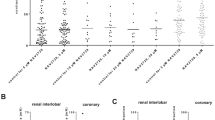Abstract
We have investigated the differences between the nitric oxide synthase inhibitor (NOSI), L-NMMA, and the guanylate cyclase inhibitors (GCI), methylene blue and LY 83583, in their abilities to increase vasoconstrictor responses in vitro and in vivo. In rat small mesenteric arterial rings, 1 h exposure to the NOSI, L-NMMA (100 μM), and the GCI, methylene blue (10 μM), alone or in combination with L-NMMA, caused a significant reduction in the maximum relaxation to ACh in mesenteric arteries pre-contracted with the thromboxane mimetic U46619 (10 μM). Hence, both NOSI and GCI inhibit endothelium-dependent relaxations to ACh in rat small mesenteric artery. However, 1 h exposure to L-NMMA and L-NNA (both 100 μM), but not methylene blue (10 μM), significantly increased the contractile response to U-46619 (10 μM) in rat small mesenteric artery. It was decided to investigate further this difference between NOSI and methylene blue. In rat small mesenteric arterial rings, L-NMMA (10 μM) and LY 83583 (1–10 μM) significantly increased the contractile response to KCl (40 mM) or to noradrenaline (10 μM), when administered during the contraction. However, methylene blue (1–10 μM) increased the contractile response to KCl but not noradrenaline. In rat aortic rings, L-NMMA (100 μM), methylene blue (1–10 μM) and LY 83583 (1–10 μM) significantly increased the contractile response to KCl (40 mM) or to noradrenaline (1 μM). In the pithed rat preparation, L-NMMA (40.3 μmol kg–1, i.v.) significantly increased the pressor response both to bolus injection of noradrenaline (3.13 nmol kg–1) and to spinal pressor nerve stimulation. However, methylene blue (3.13–15.6 μmol kg–1) or LY 83583 (4.0–40.0 μmol kg–1), failed to affect pressor responses to either NA or pressor nerve stimulation. Hence, there are differences between NOSI and GCI in their abilities to increase vasoconstrictor responses, especially when comparing responses in vitro and in vivo. This suggests that nitric oxide has actions in addition to activation of guanylate cyclase to modulate vasoconstrictor responses, presumably by membrane hyperpolarisation, and that this action may be more important in vivo.
Similar content being viewed by others
Author information
Authors and Affiliations
Additional information
Received: 2 May 1997 / Accepted: 19 June 1997
Rights and permissions
About this article
Cite this article
Abdullah, K., Cawley, T., Connolly, C. et al. Comparison of the effects of nitric oxide synthase inhibition and guanylate cyclase inhibition on vascular contraction in vitro and in vivo in the rat. Naunyn-Schmiedeberg's Arch Pharmacol 356, 481–487 (1997). https://doi.org/10.1007/PL00005080
Issue Date:
DOI: https://doi.org/10.1007/PL00005080



